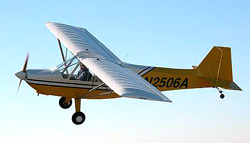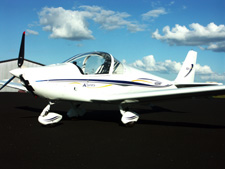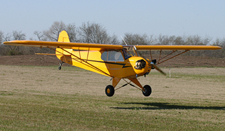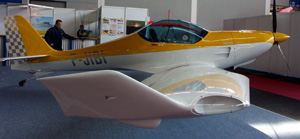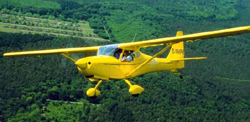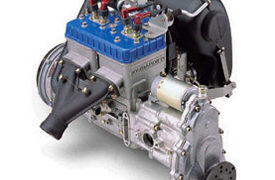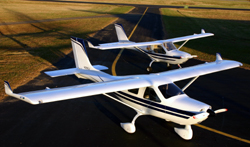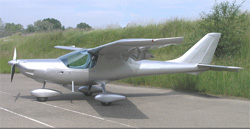The race continues and yesterday it was joined by another American producer. The race is to obtain Special Light Sport Aircraft airworthiness certificates, allowing an airplane to be fully built and sold for instructional use or rental. A company with an SLSA approval can also elect to sell an ELSA kit. RANS plans to do both. Welcome to #17 in the list of shiny new SLSA. RANS will be bringing the model to the AOPA Expo in just a few days. Come see it — and most other SLSA — in the special LSA area of the AOPA Expo airport display. RANS is perhaps the largest producer of aircraft in the LSA general description and they passed a major milestone in June 2005 when they delivered their 4,000th model since that first S-4/5 Coyote Ultralight. “Most of the dozen models RANS builds [except S-16 Shekari]…fit into the light sport plane category,” says designer Randy Schlitter.
A Gaggle of Newly Approved SLSA Models
In the last couple weeks, the number of FAA-approved Special Light-Sport Aircraft grew to 13 models. EAA keeps a current list, proved by copies of the airworthiness certificate, but I’ll list them here as: Festival, Breezer, C42, Legend Cub, Kappa KP-5 (photo), Bravo, T-211 Thorpedo, StingSport, Echo Super, Sierra, Allegro 2000, the CT, and SportStar. (The list is presented in reverse order of approval.) In a fairly short time — the first approval was announced just over three months ago — customers have been presented with many Light-Sport Aircraft choices. I’ve flown ten of these planes. Watch for my pilot reports here on the website; a few are available now.
A Legend Makes An Appearance
As a new season of flying for fun starts the Legend Cub from Sulphur Springs, Texas made its first flight. Company founders Tim Elliott and Darin Hart say their new Cub lookalike (it isn’t identical, for example, it’s got a wider cockpit) is for “recreational flyers of all ages around the world.” That’s a big statement but the popular design shape is certain to find good appeal. The Legend Cub makes its public debut at Sun ‘n Fun 2005. Look for a pilot report in an upcoming EAA Sport Pilot magazine.
Legend is First Cub to Sport a Jabiru Engine
Legend Aircraft‘s Cub is one of the top selling SLSA, ranking up high with Flight Design’s CT, Fantasy Air’s Allegro, Evektor’s SportStar, and TL Ultralight’s StingSport. Both American-made Cub-like designs (Legend’s and CubCrafters‘) have been 100% Continental O-200 powered because that engine is close to what was used in the original Piper J-3 Cub, which has driven demand from customers attracted to the vintage aircraft. However, the Cubs have higher empty weights than many of their smaller metal or composite competitors — CT and StingSport, being primarily carbon fiber airframes, weigh in almost 200 pounds lighter, for example. So, when operating at higher elevations or on floats, reported Legend staffer Pat Bowers, some owners felt more power would be useful. For several weeks the Sulphur Springs, Texas factory worked to install the Jabiru 3300. The six cylinder engine is 35 pounds lighter and has 20 more horsepower, a combination said to provided spirited performance.
IndUS Aviation’s Hot Thorpedo
IndUS Aviation’s Hot Thorpedo performs more energetically than the Continental-powered version. When you install a non-certified Jabiru 3300, six-cylinder engine into a 58-year-old certified light aircraft, you make one lively machine out of it. This relatively new company is doing things for this CAR 3-certified aircraft that legendary designer John Thorp could never do (for one, he didn’t have the Australian Jabiru powerplant). EAA’s Sport Pilot magazine (2/05) will have a full pilot report on Thorpedo. Look for it here 90+ days after publication.
Germany’s FK Lightplanes Gains a U.S. Distributor
For years, FK Lightplanes has been a leading supplier in Europe. Designs are created by Otto and Peter Funk, the father and son team that introduced the FK9 Mark IV (all-round use and trainer design), the FK12 Comet (enclosed, folding biwing), and the elegant FK14 Polaris, a modern LSA candidate available in tricycle gear or taildragger. FK planes appointed Wings of Paradise their American representative. Based in south Florida at North Perry Airport (HWO), Wings of Paradise is a longtime ultralight dealer and provider of lessons on Miami area beaches. FK Lightplanes sells models like the FK14 Polaris in 51% kit form, fast-build form, and it is available ready-to-fly. Wings of Paradise is working with the German producer to meet SLSA standards; the design is certified under Germany’s Microlight rules. E-mail contact.
FK9 Wins SLSA Certification
FK Lightplanes FK9 Mk IV becomes our 21st SLSA since April 15 (a rate of 3 per month!). A longtime ultralight enthusiast with a list of FAA ratings, importer Tony Anderson has moved fast since securing distribution of Germany’s FK Lightplanes. Since my SPLOG two days ago, Tony was able to confirm by copy of his Airworthiness Certificate the SLSA approval for the FK9 Mk IV on November 17th. Here is a proven microlight design built very lightly (590 pounds empty) using fiberglass over steel construction. Powered by a Rotax 912 or 912S, FK9 cruises at 105 knots and climbs 1,500 fpm at gross (with 100 hp engine at 1,146 pounds gross weight). In service for many years in Germany, FK9 is quite popular with flight schools. It also has the slickest of wing folding mechanisms. A single person can unhook the wing — from the tip — and fold the wing.
Rotax Certifies 582; Good for American Designs?
Perhaps a long time coming Austria-based Rotax recently certified the 65-horsepower R-582 two-stroke engine under ASTM standards. Now, some American designs may proceed with pursuing their Special Light-Sport Aircraft approval. One that pops into my mind immediately is Quicksilver‘s already-certified GT500 (under Primary Catetory from the mid-1990s) but many more could be close behind…for example, powered parachutes and other popular American ultralights. While most SLSA are hitting the gross weight limit of 1,320 pounds, LSA aren’t required to be that heavy so the 65-horse engine could be a most appropriate powerplant. One interesting note is that if A&Ps currently resist working on the 912 series what will they think of two-stroke engines? A swing factor could be Cessna, should the big company choose the lightweight 9-series Rotax over a Lycoming (part of Cessna’s corporate family). If Cessna goes Rotax, then the door may open to mechanic acceptance.
Jabiru Hits a Double with Twin Approvals
And then we had 20…SLSA approvals, that is. Jabiru’s Pete Krotje announced his company had received not one but two FAA airworthiness certificates for J250 and the new J170. The latter is aimed at the flight training market. Smaller than the J250 which has an enormous baggage area — being based on the the four-seat J400 — the J170 is based on the proven two-seat Jabiru, the Calypso. It will be powered with the company’s four cylinder, 80-hp 2200 engine. Smaller, yes, but J170 still has a broad 45-inch cabin with plenty of headroom. The J170 is big in other ways, too, with a 562 pound useful load and a whopping 35 gallons of fuel (which may not all be used in training applications). Meanwhile J250 is your cross country cruiser with room for all your gear and able to cruise easily at SP/LSA’s 120-knot speed limit.
New Parrot from Czech Aircraft Works
Looking all shiny and smooth is the new Parrot from Czech Aircraft Works (CZAW) — the Czech LSA company owned by former Wisconsin resident, Chip Erwin. Parrot adds to the amphibious Mermaid as distinct aircraft from CZAW. Some pilots know this company from its licensed production of Zenith 601 and 701 models, but they are using their engineering talent base to create their own designs. Both Parrot and Mermaid were developed very quickly and efficiently revealing an interesting marriage of American entrepreneurism and Czech airplane building skills. For more info, go to SkyShops website.


